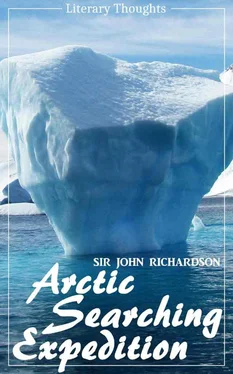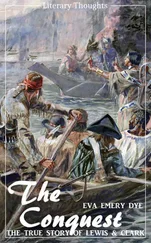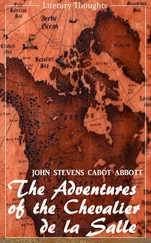The pelican, as it assembles in flocks, and is very voracious, destroys still larger quantities of fish than the eagle. It is the Pelicanus trachyrhynchus of systematic ornithologists, and ranges as far north as Great Slave Lake, in latitude 60°-61° N. These birds generally choose a rapid for the scene of their exploits, and, commencing at the upper end, suffer themselves to float down with the current, fishing as they go with great success, particularly in the eddies. When satiated, and with full pouches, they stand on a rock or boulder which rises out of the water, and air themselves, keeping their half-bent wings raised from their sides, after the manner of vultures and other gross feeders. Their pouches are frequently so crammed with fish that they cannot rise into the air until they have relieved themselves from the load, and on the unexpected approach of a canoe, they stoop down, and, drawing the bill between their legs, turn out the fish. They seem to be unable to accomplish this feat when swimming, so that then they are easily overtaken, and may be caught alive, or killed with the blow of a paddle. If they are near the beach when danger threatens, they will land to get rid of the fish more quickly. They fly heavily, and generally low, in small flocks of from eight to twenty individuals, marshalled, not in the cuneiform order of wild geese, but in a line abreast, or slightly en echellon; and their snow-white plumage with black-tipped wings, combined with their great size, gives them an imposing appearance. Exceeding the fishing eagle and the swan in bulk, they are the largest birds in the country. Their eggs are deposited on rocky islets among strong rapids, where they cannot be easily approached by man or beasts of prey. The species is named from a ridge or crest which rises from the middle line of the upper mandible of the male; sometimes from its whole length, when it is generally uneven; and sometimes from a short part only, when it is semicircular and smooth-edged.
The black-bellied tern (Hydrochelidon nigra) is also abundant on these waters, and ranges northwards to the upper part of the Mackenzie. And the Cayenne tern (Sterna cayana) is common in this quarter and onwards to beyond the arctic circle; but notwithstanding Mr. Rae's expertness as a fowler, and eagerness to procure me a specimen, the extreme wariness of the bird frustrated all his endeavours until this day, when he brought one down, and gave me an opportunity of examining it, which I was glad to do, since from want of a northern specimen the bird was not noticed in the Fauna Boreali-Americana. Mr. Audubon mentions the great difficulty of shooting this bird, and he succeeded in doing so only by employing several boats to approach its haunts in different directions. Albert, our Eskimo interpreter, told me that it does not visit Hudson's Bay.
I was also indebted to Mr. Rae's gun for specimens of the brown crane (Grus canadensis). Mr. Audubon, who is so competent an authority on all questions relating to American birds, and whose recent death all lovers of natural history deplore, was of opinion, in common with many other ornithologists, that the brown crane is merely the young of the large white crane (Grus americana); but, though I concede that the young of the latter are grey, I think that the brown species is distinct; first, because it is generally of larger dimensions than the white bird, and secondly, because it breeds on the lower parts of the Mackenzie and near the Arctic coasts, where the Grus americana is unknown. As far as I could ascertain, the latter bird does not go much further north than Great Slave Lake. At Fort aux Liards, on the River of the Mountains, large flocks of cranes pass continually to the westward, from the 17th to the 20th of September; the grey and white birds being in different bands, and the former of smaller size, like young birds. Very rarely during the summer a flock of white cranes passes over Fort Simpson in latitude 62° N. The brown cranes, on the other hand, which frequent the banks of the Mackenzie from Fort Norman, in latitude 65° N. down to the sea-coast, are generally in pairs. They are in the habit of dancing round each other very gracefully on the sand-banks of the river.
June 18th.—About three hours after embarking we came to the Pelican lightening-place (Demi-charge de chetauque), and by breakfast-time we had crossed the three portages of Woody Lake. A micaceous gneiss or mica-slate rock prevails at these portages. A family of Cree Indians, who were encamped on one of the many islands which adorn the scenery of Woody Lake, exchanged fish for tobacco, and enabled us to vary the diet of our voyagers, an indulgence which pleases them greatly; for, though they generally prefer pork or pemican to fish, they relish the latter occasionally. At five we crossed the Frog Portage, or Portage de Traitè of the Canadians, and encamped on the banks of the Missinipi or Churchill River, in the immediate vicinity of a small outpost of the Hudson's Bay Company.
No change of formation takes place in passing from the Saskatchewan River system to that of the Missinipi. The Frog Portage is low, and Churchill River, in seasons of flood, sometimes overflows it and discharges some of its superfluous waters into the Woody Lake. The general level of the country for some distance, or down to the lower end of Half-Moon Lake, varies little; but in this and in Pelican Lake there are a few conical eminences, which rise several hundred feet above the water. We did not approach them sufficiently near for examination.
Frog Portage is the most northerly point of the Saskatchewan basin, and lies in 55° 26′ N. latitude, 103° 20′ W. longitude. Below it there is a remarkable parallelism in the courses of Churchill and Saskatchewan rivers, both streams inclining to the north-east in their passage through the "intermediate primitive range," the district from whence they receive lateral supplies being at the same time very greatly narrowed. Several other considerable streams run near them, and parallel to them, but do not originate so far to the westward. In their widely spreading upper branches, and their restricted trunks, they resemble trees. As they are not separated high on the prairie slopes by an elevated water-shed, they may be considered, in reasoning upon the direction of the force which excavated their basins, as one great system, having an eastern direction and outlet, interposed between the Missouri and Mackenzie, which discharge themselves respectively into southern and northern seas.
The Churchill River is the boundary between the Chepewyans and Crees, but a few of the latter frequent its borders, resorting to Lac la Ronge and Isle à la Crosse posts, along with the Chepewyans, for their supplies.
On June the 19th, a fog detained us at our encampment to a later hour than usual; when being unwilling to lose all the morning, we went some distance in the thick weather under the guidance of the post-master, who was acquainted with every rock in the neighbourhood. As the sun rose higher the atmosphere cleared, and we ascended the Great Rapid by its southern channel, making a portage part of the way, and poling up the remainder. A recent grave with its wooden cross marked the burial-place of one of the Hudson's Bay Company's servants, who was drowned here last year. His body was thrown out a little below the rapid.
We next crossed the Rapid lightening-place, and afterwards mounted four several rapids, connected with the Barrel Portage. In the afternoon the Island Portage was made, where the river, being pent in for a short space between high, even, rocky banks, is there only five or six hundred yards wide, and has a strong current, requiring much exertion from the canoe-men in paddling round the headlands. Elsewhere, except at the rapids during this day's voyage, Churchill River has more the character of a lake. In the evening we crossed the portage of the Rapid River, one hundred and sixty paces long, which has its name from a tributary stream on which the Hudson's Bay Company have a post, that is visible from the canoe-route. Afterwards we passed the lightening-place of the Rapid River, and encamped five or six miles further on, at half-past eight o'clock.
Читать дальше












